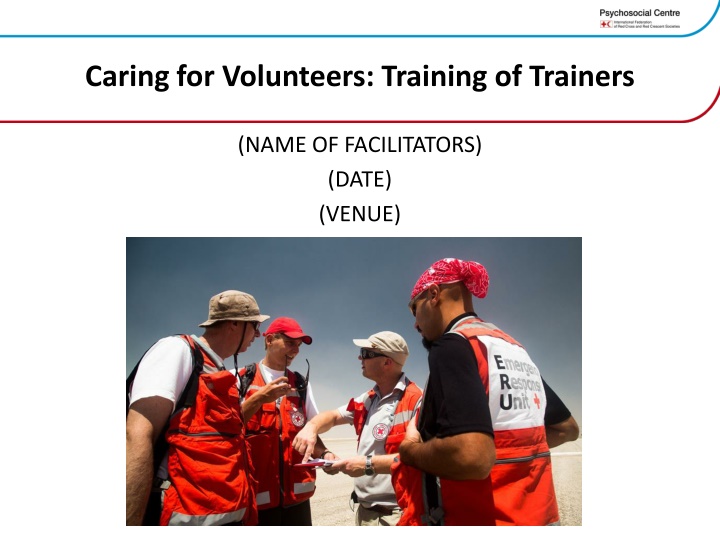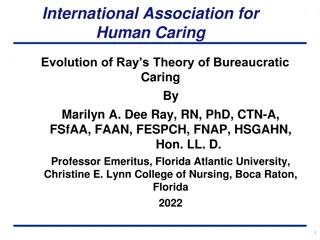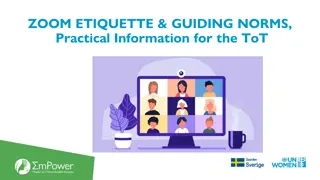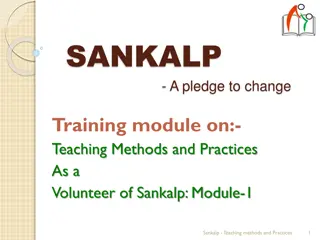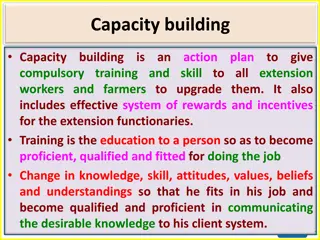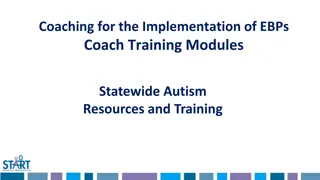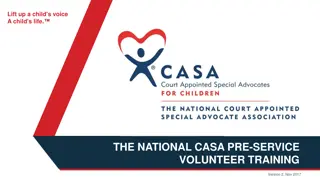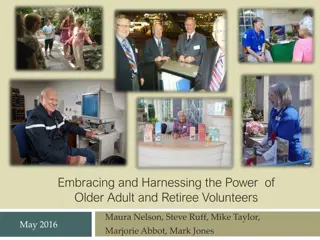Caring for Volunteers: Training of Trainers Workshop
Engage in a comprehensive training program designed to equip facilitators with the skills needed to support and empower volunteers effectively. Through a mix of sessions, participants will delve into creating inclusive environments, understanding psychosocial support, and developing action plans. The workshop highlights the importance of communication, self-care, and fostering peer support among volunteers.
Download Presentation

Please find below an Image/Link to download the presentation.
The content on the website is provided AS IS for your information and personal use only. It may not be sold, licensed, or shared on other websites without obtaining consent from the author.If you encounter any issues during the download, it is possible that the publisher has removed the file from their server.
You are allowed to download the files provided on this website for personal or commercial use, subject to the condition that they are used lawfully. All files are the property of their respective owners.
The content on the website is provided AS IS for your information and personal use only. It may not be sold, licensed, or shared on other websites without obtaining consent from the author.
E N D
Presentation Transcript
Caring for Volunteers: Training of Trainers (NAME OF FACILITATORS) (DATE) (VENUE)
Welcome An icebreaker to get to know one another The training programme Ground rules for the training
The training programme day 1 09:00-10:00 Welcome, introduction to the training programme and ground rules 10:00-10:30 Organising a training workshop 10:30-11:00 Creating a safe and inclusive learning environment 11:00-11:15 COFFEE/TEA BREAK 11:15-11:45 What makes a good facilitator? 11:45-12:15 Different learning styles 12:15-13:00 Training methods 13:00-14:00 LUNCH 14:00-16:45 Preparing a training session 16:45-17:00 Wrap up
The training programme day 2 09:00-09:45 Opening the day, explaining the programme, structuredfeedback 09:45-10:15 Group 1. Understanding psychosocial support 10:15-10:30 Feedback session 10:30-10:45 COFFEE/TEA BREAK 10:45-11:30 Group 2. Risks, resilience and protective factors 11:30:11:45 Feedback session 11:45-12:45 Group 3. Self-care 12:45-13:00 Feedback session 13:00-14:00 LUNCH 14:00-14:45 Group 4. Peer support 14:45-15:00 Feedback session 15:00-15:15 COFFEE/TEA BREAK 15:15-16:30 Group 5. Psychological first aid 16:30-16:45 Feedback session 16:45-17:00 Wrap up
The training programme day 3 09:00-09:15 Opening the day, explaining the programme for the day 09:15-10:00 Group 6. Setting up psychosocial support systems for volunteers 10:00-10:15 Feedback session 10:15-10:30 COFFEE/TEA BREAK 10:30-11:30 Group 7. Setting up psychosocial support systems for volunteers 11:30-11:45 Feedback session 11:45-12:45 Group 8. Monitoring and evaluation 12:45-13:00 Feedback session 13:00-14:00 COFFEE/TEA BREAK 14:00-15:00 Group 9. Communicating the message 15:00-15:15 Feedback session 15:15-15:30 COFFEE/TEA BREAK 15:30-15:45 Developing an action plan 15:45-16:30 Closing the ToT
Ground rules Work in pairs: Ask each other what helps to establish a good learning environment Decide on one thing that you both think is important. Write it on a post-it note. Discuss your responses in plenary.
The learning environment What kind of learning experience have you most enjoyed ? What needs to be in place for you to feel safe in a learning environment? What do you enjoy most about being a trainer? What situations would you like to be better at tackling as a trainer?
Creating a safe and inclusive environment Set ground rules Facilitate energizers and icebreakers Use a buddy system Do not probe participants experiences Be aware of strong reactions: Give participants the necessary space to react and listen to what they say. Link the person up with another participant. If someone gets distressed, talk to all the participants about it, right after it has happened.
What makes a good facilitator? In groups of three: Think about what makes a good facilitator. Now list all the functions they fulfil and the skills and qualities they may have. Record your points on post-it notes (one point per post-it). Insert photo
Learning styles The three most common learning styles are: Auditory Visual Kinesthetic Insert photo
Training methods Adults learn best in the following circumstances: When the learning builds on their experiences When the learning achieves identified goals When the learning is relevant to their daily life or is meaningful for their future When the learning can be put into effect immediately.
Different training methods Spend 15 minutes brainstorming the different methods that would best suit each learning style: Group 1: Auditory methods Group 2: Visual methods Group 3: Kinesthetic methods
Preparing a training session Group 1: Section 1: Understanding psychosocial support Group 2: Section 2: Risks, resilience and protective factors Group 3: Section 3: Self-care Group 4: Section 4: Peer support Group 5: Section 5: Psychological first aid Group 6: Section 6.1: Support strategies at each phase Group 7: Section 6.3: Developing support systems Group 8: Section 7: Monitoring and evaluation Group 9: Section 8: Communicating the message
Giving feedback Keep these things in mind when giving feedback: Let the person know what went well. For instance by saying: It was really good when you did , Doing was a really good way of getting the groups attention , The way you did was excellent! Let the person know what to do more of. For instance by saying: Continue doing , The way you seems to work well. Keep doing that. Be specific and clear. Avoid general comments such as: That was great. Be specific: It was great when you because it showed you had prepared well.
Receiving feedback Keep these things in mind when receiving feedback: Practise active listening: Keep your body language open and maintain eye contact. Don t think about how you are going to reply, just listen. Don t argue - ask for clarification, if necessary: You may want to ask clarifying questions, but you should never start arguing with the person giving you feedback. You can say, for example, Have I understood correctly that when I did , you experienced that ...?
Developing an action plan Section 9 in the Caring for Volunteers Training Manual helps participants to: define their goals for the next six months identify the actions needed to achieve those goals decide the deadline for each action identify who is responsible for following up on each action.
